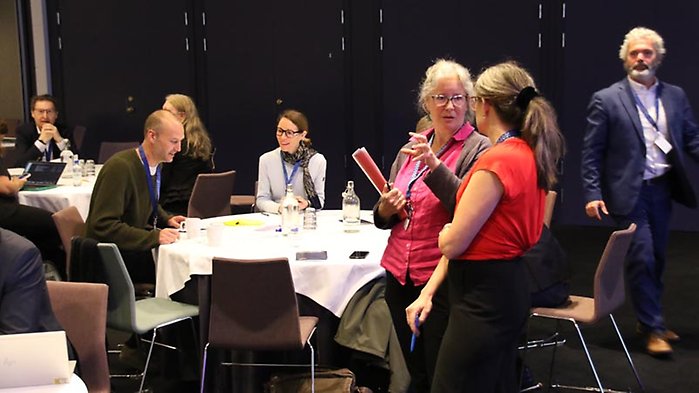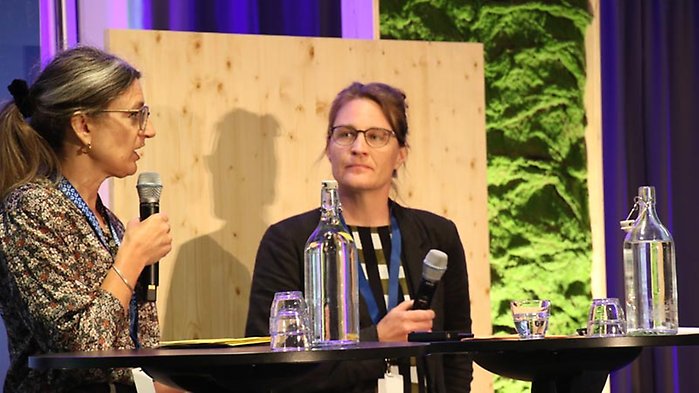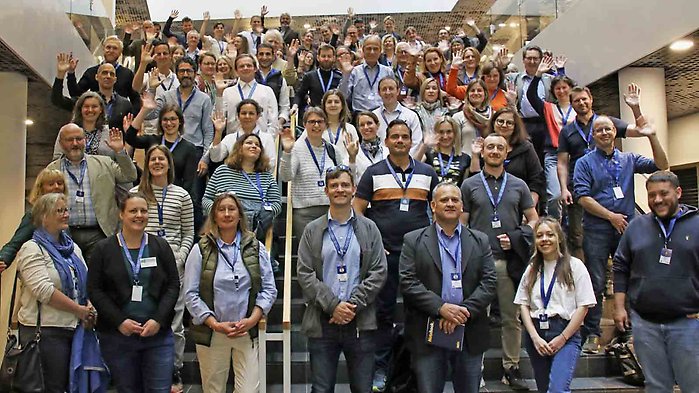
Picture from one of two breakout sessions, day 2.
Short summary of the conference
Background
Being in the start-up phase of the Strategic Plans the Ministry of Rural Affairs and Infrastructure wanted to take the opportunity to discuss the implementation of the new green architecture. It has been a great challenge for all Members States and there is an identified need to exchange experiences. The Swedish CAP Network is an active and comprehensive network with great records as organizer of such events, so it was natural for the Ministry to ask them to help with the arrangements.
The Federation of Swedish Farmers are chairperson of the group on environment and climate in the Swedish CAP Network – that got the task to plan the conference. WWF, the Swedish Society for Nature Conservation, The Swedish Beef Producer Association, the Royal Swedish Academy of Agriculture and Forestry and national environmental agencies are other organisations in that group.
The Federation of Swedish Farmers says that the network gives the possibility to work with other organisations to understand the CAP.
The conference gave the possibility to show what sustainable agriculture is about in Sweden – and to understand what it is about in other countries.
Concerence, Day 1
We were around 80 participants from 24 different countries who gathered in Malmö. Participants came from Managing Authorities, Paying Agencies, NGOs, CAP Networks, Universities and Advisory Service.
A large part of the program was interactive with marketplace, study visits and breakout sessions that gave the participants room for sharing experience.
One station at the marketplace on the first day that attracted many participants was about results-based payment schemes. There are many interesting schemes offered in the different MS (Member States), although several MS declared that it was too early to evaluate the success, and even were a little bit hesitant in terms of uptake.
In afternoon we left Malmö for study visits.
- One study visit was to a dairy farm with also arable production and a farm shop. They had organic production for 13 years but changed to conventional production last summer. The shift from organics had several reasons, of which economics was one. The consumer demand for organics has decreased in Sweden.
- Another group visited Krokstorp farm were the participants met a farmer with 440 hectares of arable land who really want to sit in the front seat by conservation agriculture and actions for biodiversity. His goal was to produce as much food as possible both today and in for the generations to come, while at the same time safeguarding environment and climate. By his practices he had not only increased biodiversity, carbon storage and infiltration capacity in the soil, but he also had reduced the use of fuel, fertilizer, chemicals and labour. At the visits it became quite evident that farmers do not only work with environmental sustainability to fulfil the CAP or to fulfil the environmental legislation.
- Study visit to Lantmännen Farm of the Future where precision farming was on the agenda: The week after our conference, EU:s CAP directors had their own meeting, and they all went to the study visit to Lantmännen Farm of the Future. Read more about the study visit in Lantmännens pressrelease (in Swedish) Länk till annan webbplats, öppnas i nytt fönster. and see the panel discussion Länk till annan webbplats, öppnas i nytt fönster. (in English).
Concerence, Day 2
Day 2 we had two breakout sessions. The first, on the Design of CAP Interventions, starting by a presentation by Gregorio Davila Diaz from DG Agri. One of the group discussions that followed was on carbon farming and as also pointed out by the commission there is a number of different schemes covering carbon farming and soil conservation, not only eco-schemes and AECC (Agri-Environment and Climate Commitments) . This is natural since the situation differs a lot between MS, this national adoption being a core principle in designing the strategic plans. There is a challenge to get farmers interested not only in the short-term commitments, but also in actions for long term carbon storage. We found that stable politics and clarity when it comes to future solid payment models for carbon farming and regulations would be needed for longer commitments.
The second session started by a presentation by Flemming Gertz from SEGES Innovation in Denmark. He gave us an example on how to engage farmers on a landscape level. The discussions that followed focused on how combinations of interventions in the green architecture and also national initiatives can enhance the implementation. The discussions showed for example that we should not forget that all the elements of the green architecture make sense when looking at them together instead of isolated as often is done. Importance of advisory service was highlighted both in the discussions but also in all study visits. There are also a lot going on under in cooperation, innovation, and Leader in terms of environment and climate, that we should not forget.
Finally, it was quite hard to get people back in the main room and to leave the break out rooms – they did not really want to end their discussions. There was a clear need for the stakeholders to discuss best practice and different ideas. Several participants asked for more conferences like this one. So hopefully a Member State will initiate a similar conference in the near future.

Åsa Wolgast Broberg, Deputy Director at the Ministry of Rural Affairs and Infrastructure, and Emma Svensson, Coordinator at the Swedish CAP network, giving a summary of the conference at the EU:s CAP directors meeting.

Family photo from the conference in Malmö, Sweden.
Find more pictures from the confercence in the photo reportage (Swedish text).
Publicerades
